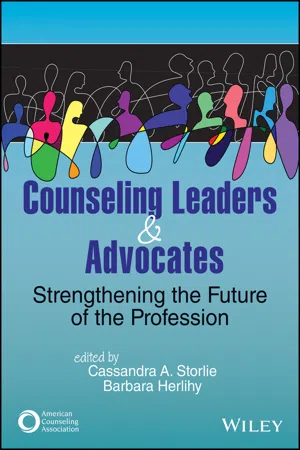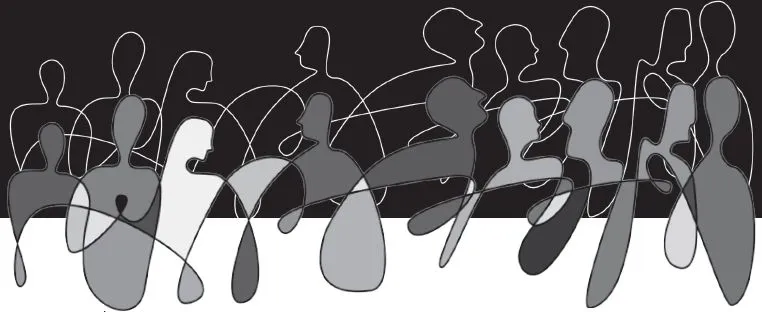In this brief introductory chapter, we share how this book came into being and provide an overview of its organization. Part I focuses generally on culturally responsive counseling leadership and counselor leadership in the field. Part II profiles 13 leaders and advocates in the counseling profession. And Part III provides a synthesis and some concluding thoughts on how you might make the best use of what you have read.
Book Development and Organization
Our plan for creating this book began serendipitously with a series of informal conversations that we enjoyed during breaks at the meetings of a national counseling organization in which we both held leadership positions at the time. We found that we shared a keen interest in leadership and advocacy and were excited to see how the counseling profession’s attention to these topics has grown in recent years. We talked about how much we had enjoyed Leaders and Legacies: Contributions to the Profession of Counseling (West et al., 2003), and as we talked, we realized that this was the most recent book that profiled leaders in our field—and nearly two decades had gone by since it was published. Some of the leaders profiled then are still active in the counseling profession and continue to make significant new contributions, others are no longer living, and some new leaders have emerged in recent times. With consultation and the inspiration of a decades’ long counseling leader, we recognized the need for a text that holistically integrated leadership and advocacy insights from current counseling leaders. It was time for a new work!
As we discussed our ideas about how to organize this book, an outline emerged for a book with three parts. These parts would capture the phenomena of counseling leadership and advocacy in counseling, the stories of individuals who have advanced our profession as leaders and advocates, and the “common threads” that unify the contributions they have made. Furthermore, it was imperative for us to emphasize practical guidance for counselors, counselor educators, and counseling students who aspire to be leaders and advocates.
Part I: Perspectives on Leadership & Advocacy in Counseling
Part I highlights current perspectives on leadership and advocacy in our profession. In addition to this chapter, two chapters provide information critical to the growth and development of new counseling leaders. In selecting this framework, we wanted readers to better understand key historical aspects of the development of the counseling profession while also considering the current social climate, particularly the impact of racial and ethnic injustices that have been prevalent throughout U.S. history. Likewise, we wanted newer professionals to have a clearer sense of what leadership and advocacy looks like on the job, to supplement what they had learned in the classroom.
Chapter 2, Culturally Responsive Counseling Leadership and Advocacy, chronicles salient aspects of the history of the American Counseling Association (ACA), including “Operationalization of the Multicultural Counseling Competencies” (Arredondo et al., 1996), the “ACA Advocacy Competencies” (Lewis et al., 2003), and the “Multicultural and Social Justice Counseling Competencies” (ACA, 2015), highlighting how they have led our profession not only in gaining multicultural competence but also in taking it a step further to engage in culturally responsive counseling leadership and advocacy. The growth in the perspective of counselors, moving from being culturally sensitive to becoming culturally responsive, is described through the lens of an ecological systems framework. The chapter authors address the history of the counseling profession and its roots in advocating for individuals and groups who are most marginalized in our society. Through transparency and engagement, the authors provide insights into how one can become a culturally responsive counseling leader and advocate by providing specific action steps in relation to the Black Lives Matter (BLM) movement. Essential characteristics of culturally responsive counseling leaders are also emphasized in this chapter. The chapter concludes with practical applications and describes how counseling students and practitioners can develop into culturally responsive counseling leaders and advocates.
Chapter 3, Leadership and Advocacy in the Field, describes how counselors advocate for their clients within the complex communities in which they reside. The chapter authors present a historical perspective that demonstrates how client advocacy has been the prominent focus for practicing counselors from the inception of our profession. Professional advocacy, which developed over time as counselors gained a sense of professional identity separate from other mental health professions, is also highlighted as a way to both unify and strengthen the counseling profession. The authors discuss how leadership and advocacy are inherently related and how advocacy initiatives taken on by counseling leaders affect our world today. Information on how to engage in the types of ground-level leadership that takes place daily within K–25 educational settings, clinical mental health and community settings, and counseling programs and universities is provided. The authors conclude by describing how counseling students and counseling practitioners can develop into servant leaders.
Part II: Leaders & Advocates—Their Stories
Part II is the “heart of the book.” It contains the personal and professional stories of 13 prominent leaders and advocates in the profession of counseling. Inspired by West et al. (2003), we established an Academy of Advisors to assist us in a systematic process to identify the leaders who are profiled in this book. The academy comprised five individuals who had held significant leadership positions in major counseling professional associations, had been widely acknowledged as leaders in the counseling profession, and remained actively engaged in the profession. As the editor spearheading this process, Cassie asked each advisor to independently generate a slate of 20 to 25 leaders/advocates they would nominate to be profiled in this book. Cassie then created a combined slate containing all names that appeared on at least two individually submitted lists. This slate was sent back to the advisors, who were then asked to narrow the list by selecting those whose “leadership and advocacy has had a long-term, broad impact on the counseling profession” and to consider “a representation of diverse leaders to be showcased.” Cassie then asked the advisors to place these names in rank order. The 13 individuals profiled in this book were ranked highest and identified most frequently by our advisors.
We are honored to present their stories, and we are painfully aware that many other exceptional leaders and advocates are equally deserving of recognition. Advancing our profession actually does “take a village,” and the full community of highly influential leaders and advocates is much, much larger than the exceptional individuals we introduce here. Our hope is that these stories will inspire you and guide you on your own path toward leadership and advocacy.
Part III: Synthesis & Concluding Thoughts
Chapter 17, Synthesis, contains a thematic analysis based on the profiles of the selected leaders and advocates. We enlisted two coauthors, an assistant professor and a doctoral student, who both have a strong interest in leadership and advocacy, to assist us in this analysis. Their engagement helped ensure that our theme identification process would represent the perspective of our readership. We discuss how the themes they discovered relate to the current literature on leadership and advocacy, both reinforcing what we know and extending our understanding as we look toward the future. This analysis reflects how the 13 leaders/advocates profiled related to and differed from one another in the spirit of strengthening the profession. A variety of reflective questions encourage you to deepen your connections to leadership and advocacy in the field of counseling.
In Concluding Thoughts, we offer our thoughts on the work as a whole and the wisdom shared by leaders as they look toward the future.
Considerations and Suggestions for Readers
We encourage you to spend intentional time reflecting on your own thoughts about counseling leadership and advocacy as you read this book. How do you understand these processes? Where are the gaps, and what remains to be done? You are the future generation of counseling leaders and advocates, and we invite you to pause and reflect on this question as you read: What motivates you in your aspirations to become a leader/advocate?
It is easier for us to answer that question as it relates to advocacy. Advocates are driven by a passion to make positive change in the lives of their clients, in the systems that contribute to marginalization and oppression of clients and client populations, and in the profession to increase our capacity to reach out and help those in need. What types of advocacy stand out for you as you read the profiles of our leaders?
What drives people toward leadership seems a bit more complex. As you will see, some leaders had a desire to lead from an early age, whereas others found themselves in leadership positions seemingly by happenstance. What kinds of leadership do we need to see more of to strengthen the profession of counseling? If you are a new counseling professional or a counseling student, this may feel like a daunting question. But those of you a little further along in your counseling career may have already established as interest in engaging leadership. Making space and time for leadership and advocacy initiatives can be a part of your regular practice, and we hope the practical suggestions in this book will assist you in reaching your goal.
Getting the Most Out of This Book
We believe you will get the most out of this book by having some brief, introductory knowledge about leadership theory and philosophy. Most notably in the counseling profession, you will come across the term servant leadership, which was first introduced by Robert Greenleaf in 1970. Greenleaf believes leadership begins with wanting to serve, and this service is followed by aspiring to lead. Servant leadership “shares power, puts the needs of others first and helps people develop and perform as highly as possible” (Center for Servant Leadership, 2020). Eva et al. (2019) described servant leadership as “a holistic leadership approach that engages followers in multiple dimensions (e.g., relational, ethical, emotional, spiritual), such that they are empowered to grow into what they are capable of becoming” (p. 111). Greenleaf (1970) emphasized how servant leaders help others grow and “become healthier, wiser, freer, [and] more autonomous” (p. 15). Servant leaders have a strong impact on the community and on their followers, and they inspire others to become servant leaders.
Servant leadership blends well with the underpinnings of the counseling profession—taking care of others and helping others to develop. Although servant leadership is often described as the core of counseling leadership practices, it is important to acknowledge that counselors embrace a variety of leadership theories. You will find a few of the following theories woven into the stories of our profiled leaders.
Authentic Leadership
Authentic leadership has been defined from intrapersonal, interpersonal, and developmental perspectives, all of which are characterized by their genuine, relational, and ethical qualities (Northouse, 2019). George (2003) identified authentic leaders as having the dimensions of purpose, values, relationships, self-discipline, and heart. George asserted that the characteristics of passion, connectedness, consistency, and compassion are required of authentic leaders. As you consider...


